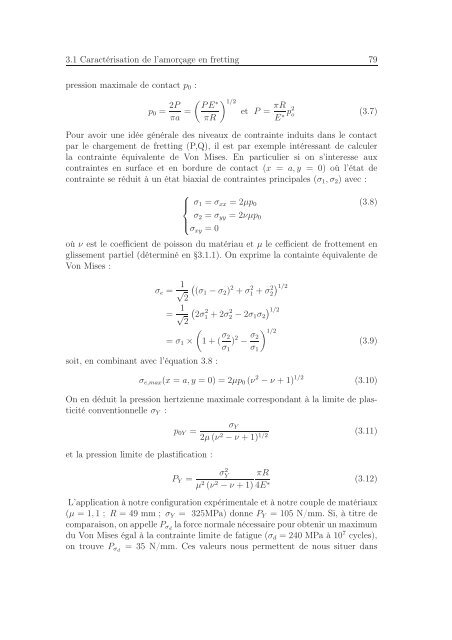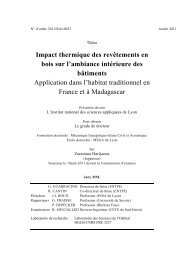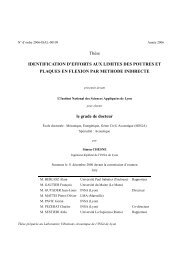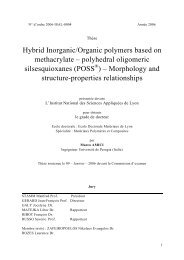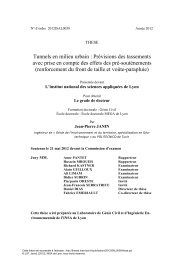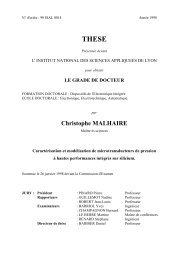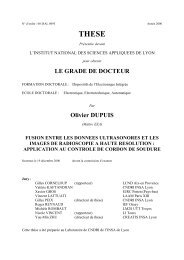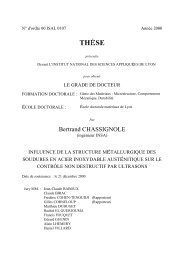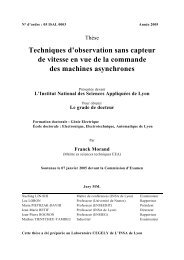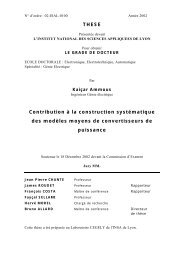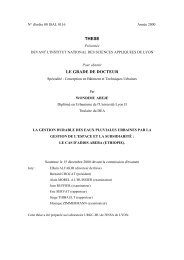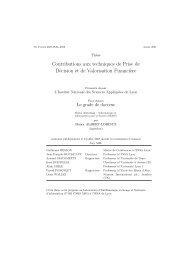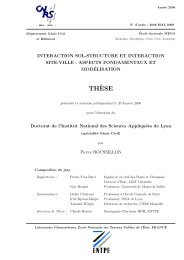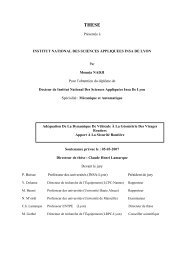Identification des mécanismes de fissuration dans un alliage d ...
Identification des mécanismes de fissuration dans un alliage d ...
Identification des mécanismes de fissuration dans un alliage d ...
Create successful ePaper yourself
Turn your PDF publications into a flip-book with our unique Google optimized e-Paper software.
3.1 Caractérisation <strong>de</strong> l’amorçage en fretting 79<br />
pression maximale <strong>de</strong> contact p 0 :<br />
p 0 = 2P ( ) PE<br />
∗ 1/2<br />
πa = et P = πR<br />
πR E ∗ p2 o (3.7)<br />
Pour avoir <strong>un</strong>e idée générale <strong><strong>de</strong>s</strong> niveaux <strong>de</strong> contrainte induits <strong>dans</strong> le contact<br />
par le chargement <strong>de</strong> fretting (P,Q), il est par exemple intéressant <strong>de</strong> calculer<br />
la contrainte équivalente <strong>de</strong> Von Mises. En particulier si on s’interesse aux<br />
contraintes en surface et en bordure <strong>de</strong> contact (x = a, y = 0) où l’état <strong>de</strong><br />
contrainte se réduit à <strong>un</strong> état biaxial <strong>de</strong> contraintes principales (σ 1 , σ 2 ) avec :<br />
⎧<br />
⎪⎨ σ 1 = σ xx = 2µp 0<br />
σ 2 = σ yy = 2νµp 0<br />
⎪⎩<br />
σ xy = 0<br />
(3.8)<br />
où ν est le coefficient <strong>de</strong> poisson du matériau et µ le cefficient <strong>de</strong> frottement en<br />
glissement partiel (déterminé en §3.1.1). On exprime la containte équivalente <strong>de</strong><br />
Von Mises :<br />
σ e = 1 √<br />
2<br />
(<br />
(σ1 − σ 2 ) 2 + σ 2 1 + σ2 2<br />
= 1 √<br />
2<br />
(<br />
2σ<br />
2<br />
1 + 2σ 2 2 − 2σ 1 σ 2<br />
) 1/2<br />
= σ 1 ×<br />
soit, en combinant avec l’équation 3.8 :<br />
) 1/2<br />
(<br />
1 + ( σ 2<br />
σ 1<br />
) 2 − σ 2<br />
σ 1<br />
) 1/2<br />
(3.9)<br />
σ e,max (x = a, y = 0) = 2µp 0 (ν 2 − ν + 1) 1/2 (3.10)<br />
On en déduit la pression hertzienne maximale correspondant à la limite <strong>de</strong> plasticité<br />
conventionnelle σ Y :<br />
p 0Y =<br />
et la pression limite <strong>de</strong> plastification :<br />
σ Y<br />
2µ (ν 2 − ν + 1) 1/2 (3.11)<br />
P Y =<br />
σ 2 Y<br />
πR<br />
(3.12)<br />
µ 2 (ν 2 − ν + 1) 4E ∗<br />
L’application à notre configuration expérimentale et à notre couple <strong>de</strong> matériaux<br />
(µ = 1, 1 ; R = 49 mm ; σ Y = 325MPa) donne P Y = 105 N/mm. Si, à titre <strong>de</strong><br />
comparaison, on appelle P σd la force normale nécessaire pour obtenir <strong>un</strong> maximum<br />
du Von Mises égal à la contrainte limite <strong>de</strong> fatigue (σ d = 240 MPa à 10 7 cycles),<br />
on trouve P σd = 35 N/mm. Ces valeurs nous permettent <strong>de</strong> nous situer <strong>dans</strong>


